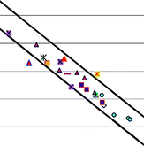
Gutowski and colleagues use a thermodynamic framework to analyze 20 different manufacturing processes that range from the conventional (machinging, casting, and injection molding) to newer, advanced processes (electrical discharge machining and vapor phase deposition techniques). Their analyses indicate that the amount of materials and energy used to process a single unit of material has increased dramatically over the past several decades.
According to the authors, this trend is due to the introduction of newer manufacturing processes—for example, processes common to the semiconductor industry introduced after the invention of the transistor, as well as newer processes used for the manipulation of nanomaterials—rather than changes to traditional manufacturing methods.
The authors are quick to note that their assessment does not provide a complete picture of new manufacturing processes, particularly those that extend product life or lower product energy requirements. Because these processes are so new, a balance between their benefits and the energy required to realize them ought to be concieved.
See:
- Gutowski TG, et al. 2009. Thermodynamic Analysis of Resources Used in Manufacturing Processes. Environmental Science and Technology [Internet]. [cited 2009 April 3]; 43(5):1584-1590. DOI: 10.1021/es8016655.
- Chandler, David. Manufacturing Inefficiency. MIT News [Internet]. 2009 March 17 [cited 2009 April 3]. Available from http://web.mit.edu/newsoffice/2009/energy-manufacturing-0317.html.
Image reproduced with permission from Gutowski TG, et al. 2009. Thermodynamic Analysis of Resources Used in Manufacturing Processes. Environmental Science and Technology 43(5):1584-1590. Copyright 2009 American Chemical Society.
